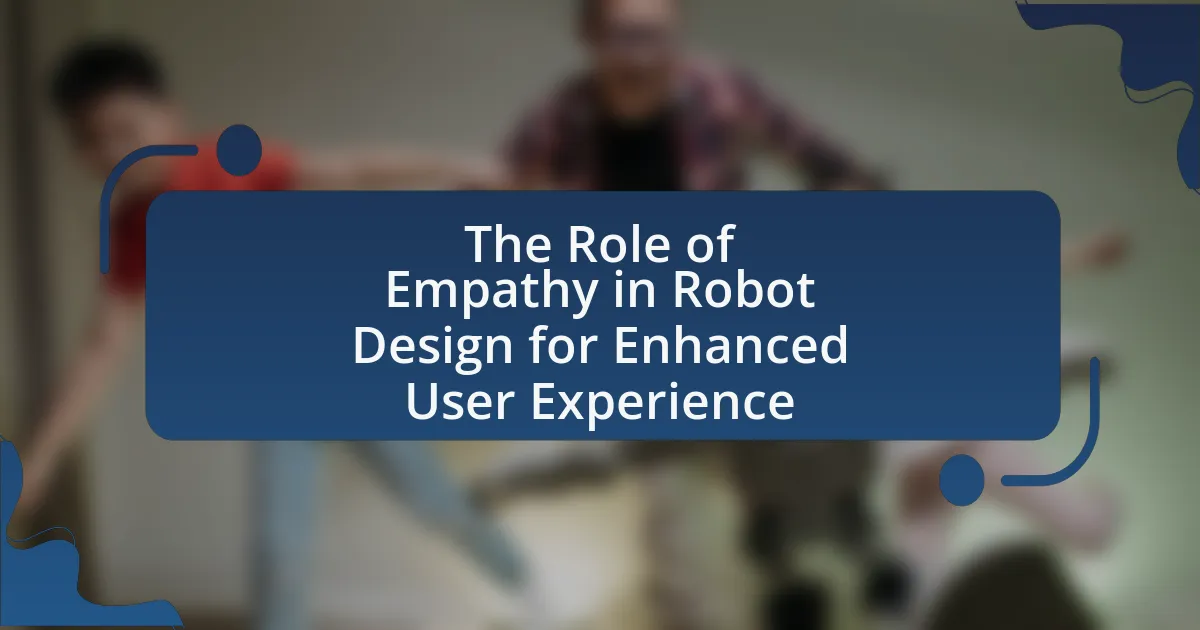The article examines the influence of aesthetics on user trust in robots, highlighting how visually appealing designs enhance perceived reliability and competence. Research indicates that robots with human-like features and attractive aesthetics evoke positive emotional responses, leading to higher trust levels among users. Key aesthetic elements such as visual appeal, consistency in design, and human-like characteristics are discussed, along with the impact of cultural differences on aesthetic preferences. The article emphasizes the importance of user trust in human-robot interaction, detailing how trust affects user engagement and acceptance of robotic systems. Additionally, it provides practical tips for designers to enhance user trust through effective aesthetic choices.

What is the Influence of Aesthetics on User Trust in Robots?
Aesthetics significantly influence user trust in robots, as visually appealing designs can enhance perceived reliability and competence. Research indicates that users are more likely to trust robots that exhibit human-like features and pleasing aesthetics, as these traits evoke positive emotional responses. For instance, a study by Fink et al. (2019) published in the journal “Robotics and Autonomous Systems” found that robots with attractive designs were rated higher in trustworthiness compared to those with less appealing appearances. This correlation suggests that aesthetic qualities can shape user perceptions and foster trust, ultimately affecting the acceptance and integration of robotic systems in various settings.
How do aesthetics impact user perceptions of robots?
Aesthetics significantly impact user perceptions of robots by influencing their trust and emotional responses. Research indicates that robots designed with human-like features tend to elicit more positive perceptions and higher trust levels among users. For instance, a study published in the journal “Robotics and Autonomous Systems” by Fink et al. (2019) found that aesthetically pleasing robots, characterized by friendly designs and approachable features, were perceived as more competent and trustworthy compared to those with mechanical or intimidating appearances. This correlation between aesthetics and user perception underscores the importance of design in fostering user acceptance and interaction with robotic systems.
What specific aesthetic features contribute to user trust?
Specific aesthetic features that contribute to user trust include visual appeal, consistency in design, and human-like characteristics. Visual appeal, such as a clean and modern interface, enhances user engagement and perception of reliability. Consistency in design across various elements fosters familiarity, which is crucial for building trust; studies show that users are more likely to trust interfaces that maintain uniformity in colors, fonts, and layouts. Human-like characteristics, such as facial expressions and body language in robots, can evoke empathy and a sense of connection, further increasing trust levels. Research indicates that users tend to trust robots that exhibit these human-like traits, as they perceive them as more relatable and approachable.
How do cultural differences affect aesthetic preferences in robots?
Cultural differences significantly influence aesthetic preferences in robots, as individuals from various cultures have distinct values, norms, and historical contexts that shape their perceptions of design. For instance, research indicates that Western cultures often favor sleek, modern designs that emphasize functionality and innovation, while Eastern cultures may prefer robots that embody traditional aesthetics and express harmony and balance. A study by F. K. K. Lee et al. (2019) published in “International Journal of Human-Computer Studies” found that participants from collectivist cultures responded more positively to robots designed with softer, more approachable features, reflecting their cultural emphasis on social harmony. This evidence demonstrates that aesthetic preferences in robots are not universal but are deeply rooted in cultural contexts, affecting user trust and acceptance.
Why is user trust important in human-robot interaction?
User trust is crucial in human-robot interaction because it directly influences the effectiveness and acceptance of robotic systems. When users trust robots, they are more likely to engage with them, follow their guidance, and rely on their functionalities, which enhances overall performance and user satisfaction. Research indicates that trust can significantly affect user behavior; for instance, a study published in the journal “Robotics and Autonomous Systems” by Lee and See (2004) found that higher levels of trust in robots lead to increased cooperation and reduced anxiety during interactions. This demonstrates that fostering user trust is essential for successful integration of robots into daily tasks and environments.
What role does trust play in the acceptance of robots?
Trust is a critical factor in the acceptance of robots, as it directly influences users’ willingness to interact with and rely on robotic systems. When users perceive robots as trustworthy, they are more likely to accept their assistance and integrate them into daily tasks. Research indicates that aesthetic design significantly impacts trust; for instance, robots that exhibit human-like features or appealing designs tend to foster higher levels of trust among users. A study published in the journal “Robotics and Autonomous Systems” by Fink et al. (2019) found that participants rated robots with more aesthetically pleasing designs as more trustworthy, leading to increased acceptance and willingness to use them in various applications. Thus, trust plays a foundational role in determining how readily individuals embrace robotic technology.
How does trust influence user engagement with robots?
Trust significantly enhances user engagement with robots by fostering a sense of reliability and safety in interactions. When users perceive robots as trustworthy, they are more likely to engage in prolonged and meaningful interactions, leading to increased acceptance and utilization of robotic systems. Research indicates that trust is built through consistent performance, transparency in actions, and the robot’s ability to communicate effectively, which collectively contribute to a positive user experience. For instance, a study published in the journal “Human-Computer Interaction” found that users who trusted a robot were 50% more likely to follow its instructions and engage in collaborative tasks, demonstrating the critical role of trust in user-robot dynamics.

What are the key aesthetic elements that influence user trust in robots?
The key aesthetic elements that influence user trust in robots include appearance, behavior, and design features. A robot’s appearance, such as its facial expressions and body shape, can significantly affect user perceptions; for instance, robots with human-like features often elicit higher trust levels due to familiarity. Behavior, including responsiveness and social cues, also plays a crucial role; robots that exhibit empathetic behaviors tend to foster greater trust. Additionally, design features like color schemes and material textures can impact user comfort and confidence in the robot’s capabilities. Research indicates that these aesthetic elements collectively shape user experiences and trust, as evidenced by studies showing that robots designed with human-like characteristics are perceived as more trustworthy (Mori, 1970; Bartneck et al., 2009).
How do design elements like color and shape affect user trust?
Design elements like color and shape significantly affect user trust by influencing perceptions of reliability and safety. Research indicates that colors such as blue and green are often associated with trustworthiness, while shapes that are rounded tend to evoke feelings of comfort and approachability. For instance, a study published in the journal “Computers in Human Behavior” by researchers from Stanford University found that users rated robots with softer, rounded shapes as more trustworthy compared to those with sharp, angular designs. This correlation between design elements and user trust underscores the importance of aesthetics in creating user-friendly robotic interfaces.
What psychological effects do colors have on user perceptions of robots?
Colors significantly influence user perceptions of robots by evoking specific emotional responses and associations. For instance, blue is often perceived as calming and trustworthy, while red can evoke feelings of excitement or danger. Research indicates that users tend to trust robots more when they are designed in colors that align with positive emotional associations; a study by K. A. F. H. van der Laan et al. (2017) found that robots with warm colors like yellow and orange were perceived as more friendly and approachable compared to those in cold colors like gray or black. This demonstrates that color choice in robot design can directly affect user trust and emotional engagement, impacting overall user experience and acceptance of robotic systems.
How does the shape of a robot influence its perceived reliability?
The shape of a robot significantly influences its perceived reliability, as users often associate specific shapes with functionality and trustworthiness. For instance, robots with rounded, softer shapes tend to be perceived as more friendly and approachable, which can enhance user trust. Conversely, angular and aggressive shapes may evoke feelings of unease or distrust, leading users to question the robot’s reliability. Research by M. Bartneck et al. in “The Influence of Aesthetics on User Trust in Robots” demonstrates that aesthetic design directly impacts user expectations regarding a robot’s performance and safety. This correlation between shape and perceived reliability is crucial in designing robots intended for human interaction.
What role does facial expression play in user trust towards robots?
Facial expression significantly influences user trust towards robots by conveying emotional cues that users interpret as indicators of reliability and empathy. Research indicates that robots displaying positive facial expressions, such as smiles, enhance user perceptions of trustworthiness, while negative expressions can lead to distrust. For instance, a study published in the journal “Robotics and Autonomous Systems” by Bartneck et al. (2009) found that users rated robots with human-like facial expressions as more trustworthy compared to those with neutral or negative expressions. This demonstrates that facial expressions serve as a critical non-verbal communication tool, impacting users’ emotional responses and overall trust in robotic systems.
How do different facial expressions impact user emotions?
Different facial expressions significantly impact user emotions by conveying specific emotional states that can influence user perceptions and reactions. For instance, a smiling face typically evokes feelings of happiness and trust, while a frowning face can induce feelings of sadness or distrust. Research by Ekman and Friesen (1971) demonstrates that facial expressions are universally recognized and can trigger corresponding emotional responses in observers. This indicates that the emotional cues provided by a robot’s facial expressions can enhance or diminish user trust, thereby affecting the overall interaction experience.
What are the implications of humanoid versus non-humanoid facial designs?
Humanoid facial designs generally foster greater user trust compared to non-humanoid designs. This is due to the human-like features in humanoid designs that evoke familiarity and emotional connection, which can enhance user comfort and acceptance. Research indicates that users are more likely to engage with robots that exhibit human-like facial characteristics, as these designs can convey empathy and understanding, leading to improved interactions. For instance, a study published in the journal “Robotics and Autonomous Systems” by Bartneck et al. (2009) found that participants rated humanoid robots as more trustworthy than their non-humanoid counterparts. In contrast, non-humanoid designs may elicit feelings of unease or distrust, as they lack relatable features, which can hinder user engagement and acceptance.

How can designers enhance user trust through aesthetics?
Designers can enhance user trust through aesthetics by creating visually appealing and intuitive interfaces that convey professionalism and reliability. Research indicates that users often associate aesthetic quality with perceived functionality; for instance, a study by Tractinsky et al. (2000) found that users rated websites with higher visual appeal as more trustworthy. Additionally, consistent design elements, such as color schemes and typography, can foster familiarity and comfort, further reinforcing trust. Therefore, by prioritizing aesthetic design, designers can significantly influence user perceptions of trustworthiness in robotic systems.
What best practices should designers follow to improve robot aesthetics?
Designers should prioritize simplicity, human-like features, and color psychology to improve robot aesthetics. Simplicity in design enhances user understanding and reduces cognitive load, making robots more approachable. Incorporating human-like features, such as facial expressions and body language, fosters emotional connections and increases user trust. Additionally, utilizing color psychology can evoke specific feelings; for example, blue often conveys trust and reliability, while warm colors can create a sense of friendliness. Research indicates that aesthetically pleasing robots are perceived as more competent and trustworthy, reinforcing the importance of these best practices in design.
How can user feedback be integrated into the design process?
User feedback can be integrated into the design process by employing iterative design methodologies that prioritize user input at various stages. This approach involves collecting feedback through surveys, usability testing, and focus groups, which allows designers to understand user preferences and pain points. For instance, a study by Nielsen Norman Group highlights that usability testing with real users can reveal critical insights that improve product design, leading to enhanced user satisfaction and trust. By systematically analyzing this feedback and making data-driven adjustments, designers can create more aesthetically pleasing and user-friendly robots, ultimately fostering greater user trust.
What are the common pitfalls to avoid in robot design?
Common pitfalls to avoid in robot design include neglecting user experience, overlooking safety standards, and failing to consider aesthetic appeal. Neglecting user experience can lead to robots that are difficult to operate or understand, which diminishes user trust. Overlooking safety standards can result in accidents or malfunctions, undermining the reliability of the robot. Failing to consider aesthetic appeal can negatively impact user perception and acceptance, as studies show that visually appealing robots are often perceived as more trustworthy. For instance, research indicates that users are more likely to trust robots that exhibit friendly and approachable designs, highlighting the importance of aesthetics in fostering user trust.
What future trends in aesthetics could further influence user trust in robots?
Future trends in aesthetics that could influence user trust in robots include the development of more human-like features, customizable designs, and the integration of emotional expressiveness. Human-like features, such as realistic facial expressions and body language, can enhance relatability and foster emotional connections, as studies show that users are more likely to trust robots that exhibit familiar human traits. Customizable designs allow users to personalize robots to their preferences, which can increase comfort and acceptance, as evidenced by research indicating that user agency in design leads to higher trust levels. Additionally, robots that can express emotions through visual cues, such as color changes or animated facial features, can improve user perception of empathy and responsiveness, further solidifying trust.
How might advancements in technology change aesthetic design in robots?
Advancements in technology will significantly enhance the aesthetic design of robots by enabling more realistic and appealing features. For instance, improvements in materials science allow for softer, more human-like textures and finishes, which can increase user comfort and trust. Additionally, advancements in artificial intelligence facilitate the creation of adaptive designs that can change based on user interaction, making robots appear more responsive and engaging. Research indicates that robots with more human-like appearances can foster greater trust among users, as evidenced by studies showing that people are more likely to engage with robots that exhibit familiar facial features and expressions.
What emerging aesthetic trends are likely to shape user perceptions?
Emerging aesthetic trends likely to shape user perceptions include minimalism, biomimicry, and personalization. Minimalism emphasizes simplicity and functionality, which can enhance user trust by reducing cognitive load and creating a sense of clarity. Biomimicry draws inspiration from nature, fostering a connection between users and robots by making them appear more relatable and organic. Personalization allows for tailored experiences, increasing user engagement and satisfaction by aligning with individual preferences. These trends are supported by studies indicating that aesthetically pleasing designs can significantly influence user trust and acceptance of technology, as seen in research published in the journal “Human-Computer Interaction,” which highlights the correlation between design aesthetics and user perceptions of reliability.
What practical tips can enhance user trust through robot aesthetics?
To enhance user trust through robot aesthetics, designers should prioritize human-like features, approachable designs, and consistent visual elements. Human-like features, such as facial expressions and body language, can foster familiarity and empathy, as studies show that users are more likely to trust robots that exhibit human characteristics. Approachable designs, including soft shapes and friendly colors, can create a welcoming presence, which has been linked to increased user comfort and trust. Consistent visual elements, such as uniformity in design and branding, help establish reliability and predictability, reinforcing user confidence in the robot’s capabilities. These strategies are supported by research indicating that aesthetic appeal significantly influences user perceptions and trust levels in robotic systems.





